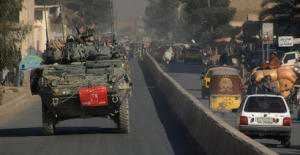Articles >>
Canadian Army to upgrade combat vehicle fleets
Category: Defence Industry

Oromocto, New Brunswick -- The Army will improve or replace its fleets of combat vehicles, providing soldiers with greater protection, mobility and lethality on the battlefield. Calling it “a great day for the Army,” Lieutenant-General Andrew Leslie announced the $5.2 billion vehicle upgrade and acquisition projects together with federal cabinet ministers July 8 at CFB Gagetown. The renewal of the fleets will make the Army’s combat vehicles “bigger, harder, faster and better-armed,” the Chief of the Land Staff told about 300 soldiers assembled to hear the announcement. Troops deserve most effective equipment
Noting that every day Canadian troops “risk everything to ensure the security of their fellow Canadians and those they are sent to help,” LGen Leslie said they deserve nothing less than the best level of protection and the most effective equipment the CF can provide. The combat fleet renewal encompasses four projects:
Army has been forced to run its combat vehicles very hard
During the mission in Afghanistan, the Army has been forced to run its combat vehicles very hard on rugged terrain. Taliban insurgents have developed more powerful weapons, especially IEDs, and all NATO armies are seeking ways to upgrade protection for their troops. Defence contractors are focusing heavily on ways to improve the protection of combat vehicles. The Coyote has served the Army well but more protection is required and the surveillance suites need upgrading to today’s technology. The Army also hopes to improve the interior ergonomics in the TAPV – space is very cramped in the Coyote, especially when soldiers are required to wear all of their kit including ballistic shields. The TAPV will also fill a long-standing requirement for an agile, well-protected vehicle to move light infantry and materiel. Projects have been approved
While the projects have been approved, final decisions will not be reached on all specifications for the new vehicles until discussions are completed with potential manufacturers. The Project Director for the CCV, Major Robert Bouchard, said the vehicle will have a high level of off-road mobility and “at least the firepower of a LAV III.” There will be an infantry vehicle and another to serve in a forward observation role. The CCV will have state-of-the-art digital communications suites and other electronics. Weighing in at between 30 and 45 tonnes, it will be deployed to theatre by ship or C-17. Major Richard Toppa, Project Director for the AEVs and the ARVs, said they represent a “quantum leap forward” in crew protection over the Badger. They will have an increased power pack, improved hydraulics and 2010 or 2011 technology, compared with 1983-84 technology in the Badger. The Army will also acquire dozer blades, mine ploughs and mine rollers. Initial operational capability for the AEVs and ARVs is scheduled for 2011; for the upgraded LAV IIIs and the CCV 2012; and for the TAPV in 2013. Number of vehicles:
|
Paul Mooney |
KONGSBERG CONCLUDES A $ 54 MILLION CONTRACT FOR THE DELIVERY WEAPON STATIONS TO CANADIAN ARMY
05.06.2020
Rheinmetall at DSEI 2017
12.09.2017
General Dynamics Land Systems-Canada to update Canadian Army's LAV fleet
11.02.2017
Polaris Wins Canadian Special Forces Ultra-Light Combat Vehicle Contract
03.02.2017
Discuss
